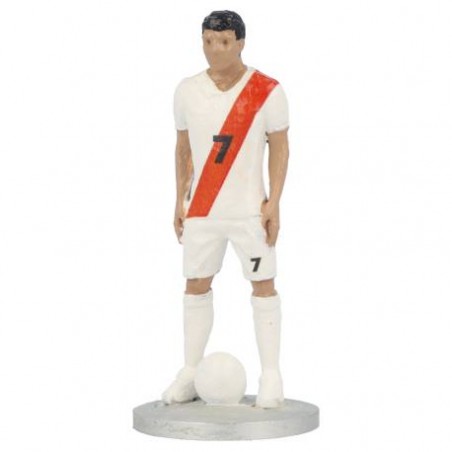




Miniature football player with kit of the national team of Peru.
Our football players are casted in metal, and afterwards painted with care and sense for detail. Also discover our other football players.

Pay safely

Fast delivery

Return & Refund
The Peruvian national football team is the selection team of the Peruvian Football Federation (FPF) and represents Peru at international level. The national team has participated in five World Cups so far (1930, 1970, 1978, 1982, 2018). While they failed in the preliminary round in 1930, 1982 and 2018, they reached the quarter-finals and the intermediate round in 1970 and 1978 respectively.
In 1927, Peru participated for the first time in the Copa América, which the country hosted. The first match at the Copa was also the first international match. Peru won the Copa América in 1939 and 1975. In recent years, Peru has usually been eliminated in the quarter-finals and only reached the semi-finals again in 2011, when it lost 2-0 to Uruguay. In the third-place match that followed, Peru beat Venezuela 4-1, with Paolo Guerrero scoring three goals. Peru repeated that success at the 2015 Copa América after a 2-0 win over the same opponents. In 2019, the team reached the final of the Copa America for the first time in over forty years, finishing as a losing team.
Peruvian footballers had their greatest period in the 1970s. The star of this team was the goal scorer Teófilo Cubillas, who scored ten times in 13 World Cup matches. Peru's best ranking in the FIFA World Ranking, which has been maintained since 1993, came in October 2017 after qualifying for the 2018 World Cup, which saw Peru in the top ten for the first time.
Peru has participated in five World Cups. Peru delivered a special match at the World Cup in Argentina on 21 June 1978. Peru had entered a second final group with three other teams. After the first two games, Peru had no chance of reaching the game for third place or the final. The Argentines and Brazilians had drawn. Brazil had already played their games and Argentina not only had to beat Peru to reach the final, but they had to win big. Peru lost 6-0, and the suspicion lingered for a long time that the Argentine military junta had bought the high victory with grain deliveries to the Peruvian state. In the book "We Were World Champions" by Ricardo Gotta, Peruvian national players tell of calls from their head of state, of visits by dictator Jorge Videla and US Secretary of State Henry Kissinger to their dressing room. To defender José Velazquez it seemed "quite strange, there was pressure". Goalkeeper Ramón Quiroga, a native Argentine, did not have a good day in the 6-0 loss and later said he was "sure that some people took something. We saw strange things". Years later, Peruvian senator Genaro Ledesma confessed that Argentina had bought the match. In March 2007, former 52-time international Julio César Uribe took over as coach from Francisco Maturana. However, Uribe resigned again in July 2007. His successor was José del Solar. From July 2010 to February 2014, the Uruguayan Sergio Markarián was Peru's national coach. He was followed by his assistant Pablo Bengoechea in March 2014. After Ricardo Gareca took over the national team in 2015, it managed to qualify for the 2018 World Cup in Russia, its first World Cup appearance in 36 years. At the Copa America 2019, Peru reached the final of an international tournament for the first time in 44 years. There, they lost 3-1 to Brazil.
Peru's national colours are red and white. These are reflected in the national team's player uniforms. The first jerseys were striped red and white in the 1920s. Until 1936, this style changed several times. For the 1936 Summer Olympics in Berlin, the federation introduced its home jersey, which is still common today, for the first time. From then on, a white jersey with a red bar running from the bottom left to the top right became the recognisable feature of the Peruvian national team. This look has been adopted by a wide variety of sporting goods manufacturers and also offered to the South American team.
Data sheet